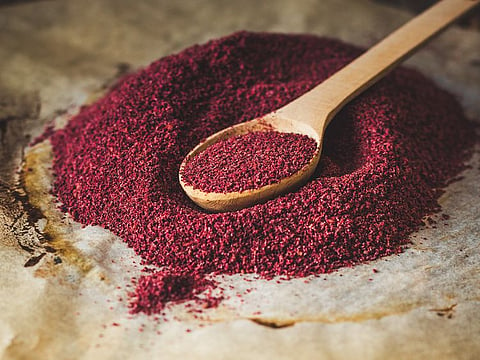Sumac: The Middle Eastern spice that acts as a secret flavour enhancer
Sumac - a spice made with ground wild berries, that tastes tangy

Dubai: Your favourite bowl of hummus or the plate of musakhan you order have an essential spice in common that is yet to shine in the mainstream markets. But visit Dubai's spice souk, and you will smell of it in abundance. We are talking about sumac - a dark-red coloured spice known for its tangy flavour and acidic component.
Chances are, if you have eaten Middle Eastern or Levant dishes dusted with zaatar (a spice mix of dried oregano, thyme, and/or marjoram, sumac and toasted sesame seeds) then you have tasted sumac. It is a crucial ingredient used in this spice mix. The bright red tinge on hummus or the acidic and tangy component in kebabs or chicken marinade, comes from sumac. Across cuisines and homes, sumac holds a special place.
Dubai-based Lebanese expatriate, recipe developer and social media content creator Yasmine Idriss Tannir told the Gulf News Food team: "Sumac is a healthy berry and a healthy spice that is relatively inexpensive. It adds a lot of tang and acidity to recipes, sauces, salad sauces, and marinades with chicken and onions. Also, it is used in zaatar mix, which is the key to making manoushe zaatar or Lebanese flatbread."
Sumac's Middle Eastern appeal
A rich history of sumac, nearly 2000 years' old reflects this spice's popularity across Middle Eastern kitchens. Home cooks and chefs keep this zesty powder in their spice arsenal to notch up the flavour of a dish.
A celebrated spice powder in Turkey, Head Chef Muhammet Ors at Babaji Istanbul restaurant, Dubai, explained sumac's historical significance.
Sumac was widely used to add sourness and colour to a dish since the Ottoman Empire time. Owing to its unique taste and health benefits, such as being an anti-oxidant, its usage can be credited to more than just taste." This ground spice is primarily used in Turkish salads, dolma (dishes with filling), and kebabs.

In many Lebanese kitchens, this acidic spice powder is a staple, and Yasmine's kitchen is no different. This acidic spice powder is essential in Yasime's kitchen pantry. Sumac is used in the most popular Lebanese salad, called fattoush, similar to a Greek salad, except it does not use feta cheese and olive. She added: "We use lots of herbs, fried bread, pomegranate molasses, crushed garlic and sumac. We also use it for marinades, especially Levant dishes like chicken musakhan, for a rich and tangy taste." Many times, she uses it as a replacement for lemon. She often buys her stock of sumac from an artisanal Lebanese spice shop, offline or online. While buying a packet from the market, she advises reading the ingredients, making sure nothing else is mixed, and always going for a freshly ground, dry powder. Typically a batch of sumac powder can last up to a year, provided you store it away from heat and direct sunlight.
Cooking comes naturally to Yasmine, and it could be because she grew up in a home where food was cooked and eaten with love. Sharing a sweet memory from her childhood, she recalls a dish, probably the only dish her father cooks – Beyd bi sumac or eggs with sumac. It is basically fried egg in a clay pot with sliced garlic and sumac. She said:
My father is the only one who can cook Beyd bi sumac or eggs with sumac the way I like and one of the reasons why this spice holds a special place in my heart

For 13-year-old Abdulrahman Al Hashmi and Maitha Al Hashmi, UAE's youngest twin Emirati chefs, sumac is often used in their cooking.
I like to use it in my cooking because it has a delightful and robust flavour like that of lemon. Not only that, its purplish maroon colour imparts a natural pink colour to the dish I cook, especially grilled chicken or pan-fried or oven-baked chicken

Like her brother, Maitha likes to add this spice for marination or sprinkle it. She said: I like to create interesting patterns on top of a dish.
I like to create interesting patterns on top of a dish

How to spot an edible sumac shrub in the wild?
Sumac berries come from the edible part of the Rhus Coriaria shrub, found typically in high plateau areas of the Mediterranean. These flowering plants have fern-like pinnate leaves, with cone-shaped clusters of white or fuzzy red berries. But remember, not all sumac berries are edible, the white ones are poisonous, and one way to identify them is to look out for mushy ground, as they tend to grow in wet places.
The berries of the edible shrubs are picked when fully ripe, dried and ground, making its colour change to red-burgundy. The processed sumac powder smells like lemon but not so strong.
Sumac shrubs are also grown in Turkey and parts of Iran. Another variant that goes by the name Rhus typhina, is a lesser-known berry found in North America.
In parts of Canada and Northern Mexico, sumac berry shrubs such as Rhus glabra, Rhus aromatica, and Rhus copallinum. The berries are used to prepare delectable North American Sumac infused cold teas that go by the name sumacade, pronounced similar to lemonade.
A royal medicine in ancient Rome
Many online publications and food historians cite that sumac was derived from the Aramaic word 'summaq', which translates to dark red. First discovered for medicinal usage, it was widely used as an anti-flatulent by Roman Emperor Nero's physician, Pedanius Dioscorides. Way before lemon came to be used in Europe, Romans used sumac.
Here are some classic recipes that use sumac:
Do you have a favourite recipe to share with us? Write to us at food@gulfnews.com
Sign up for the Daily Briefing
Get the latest news and updates straight to your inbox



